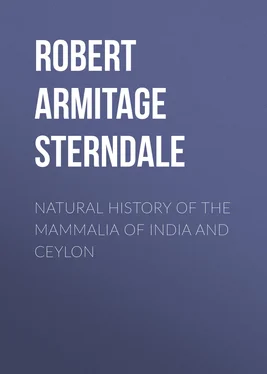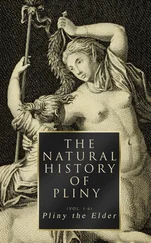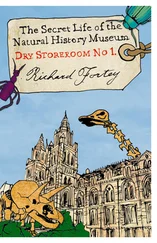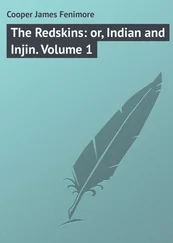Robert Armitage Sterndale - Natural History of the Mammalia of India and Ceylon
Здесь есть возможность читать онлайн «Robert Armitage Sterndale - Natural History of the Mammalia of India and Ceylon» — ознакомительный отрывок электронной книги совершенно бесплатно, а после прочтения отрывка купить полную версию. В некоторых случаях можно слушать аудио, скачать через торрент в формате fb2 и присутствует краткое содержание. Жанр: foreign_edu, Биология, на английском языке. Описание произведения, (предисловие) а так же отзывы посетителей доступны на портале библиотеки ЛибКат.
- Название:Natural History of the Mammalia of India and Ceylon
- Автор:
- Жанр:
- Год:неизвестен
- ISBN:нет данных
- Рейтинг книги:5 / 5. Голосов: 1
-
Избранное:Добавить в избранное
- Отзывы:
-
Ваша оценка:
- 100
- 1
- 2
- 3
- 4
- 5
Natural History of the Mammalia of India and Ceylon: краткое содержание, описание и аннотация
Предлагаем к чтению аннотацию, описание, краткое содержание или предисловие (зависит от того, что написал сам автор книги «Natural History of the Mammalia of India and Ceylon»). Если вы не нашли необходимую информацию о книге — напишите в комментариях, мы постараемся отыскать её.
Natural History of the Mammalia of India and Ceylon — читать онлайн ознакомительный отрывок
Ниже представлен текст книги, разбитый по страницам. Система сохранения места последней прочитанной страницы, позволяет с удобством читать онлайн бесплатно книгу «Natural History of the Mammalia of India and Ceylon», без необходимости каждый раз заново искать на чём Вы остановились. Поставьте закладку, и сможете в любой момент перейти на страницу, на которой закончили чтение.
Интервал:
Закладка:
The above description reminds one forcibly of the habits of squirrels, so it is no wonder that at one time these little creatures were confounded with the Sciuridæ .
The dentition of this genus is as follows: Either four or six incisors in the upper jaw, but always six in the lower; four premolars and three molars in each jaw, upper and lower. The skull has a complete bony orbit, and the zygomatic arch is also complete, but with a small elongated perforation; the muzzle attenuated, except in T. Ellioti ; ears oval; the stomach possesses a cæcum or blind gut; the eyes are large and prominent, and the tail bushy, like that of a squirrel; the toes are five in number, with strong claws; the shank-bones are not united as in the hedgehogs. The diet is mixed insectivorous and frugivorous.
HABITAT.—Southern India, Godavery district, Cuttack; the Central Provinces, Bhagulpore range.

DESCRIPTION.—Fur pale rufous brown, darker on the back and paler on the sides; the chin, throat, breast and belly yellowish, also a streak of the same under the tail; the upper surface of the tail is of the same colour as the centre of the back; there is a pale line from the muzzle over the eye, and a similar patch beneath it; the fur of this species is shorter and more harsh, and the head is more blunt than in the Malayan members of the family.
SIZE.—Head and body, 7 to 8 inches; tail, 7 to 9 inches.
HABITAT.—Sikim (Darjeeling), Assam and through Arakan to Tenasserim.
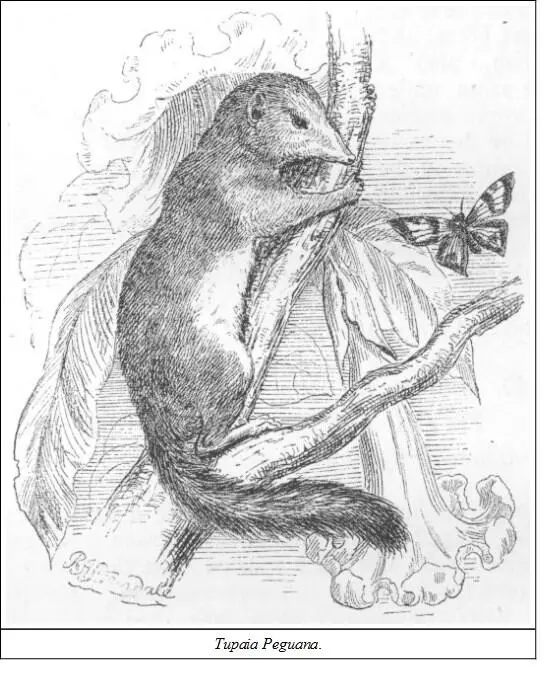
DESCRIPTION.—Jerdon says: "General hue a dusky greenish-brown, the hairs being ringed brown and yellow; lower parts the same, but lighter; and with a pale buff line; a stripe from the throat to the vent, broadest between the forearms and then narrowing; ears livid red, with a few short hairs; palms and soles dark livid red." Dr. Anderson remarks that the fur is of two kinds of hairs—one fine and wavy at the extremity, banded with black, yellow and black; the second being strong and somewhat bristly, longer than the other, and banded with a black basal half and then followed by rings of yellow and black, then yellow again with a black tip, the black basal half of the hairs being hidden, the annulation of the free portions produces a rufous olive-grey tint over the body and tail.
SIZE.—Head and body about 7 inches; tail, 6½.
Jerdon says of it that those he procured at Darjeeling frequented the zone from 3000 to 6000 feet; they were said by the natives to kill small birds, mice, &c. The Lepcha name he gives is Kalli-tang-zhing . McMaster in his notes writes: "The Burmese Tupaia is a harmless little animal; in the dry season living in trees and in the monsoon freely entering our houses, and in impudent familiarity taking the place held in India by the common palm squirrel. It is, however, probably from its rat-like head and thievish expression, very unpopular. I have found them in rat-traps, however, so possibly they deserve to be so." He adds he cannot endorse the statement regarding their extraordinary agility mentioned by Dr. Cantor and quoted by Jerdon, for he had seen his terriers catch them, which they were never able to do with squirrels; and cats often seize them.
Mason says: "One that made his home in the mango-tree near my house at Tonghoo made himself nearly as familiar as the cat. Sometimes I had to drive him off the bed, and he was very fond of putting his nose into the teacups immediately after breakfast, and acquired a taste both for tea and coffee. He lost his life at last by incontinently walking into a rat-trap."
The Burmese name for it is Tswai in Arracan. Jerdon states that it is one of the few novelties that had escaped the notice of Mr. Brian Hodgson, but Dr. Anderson mentions a specimen (unnamed) from Nepal in the British Museum which was obtained by Hodgson.
HABITAT.—Burmah, Kakhyen hills, east of the valley of the Irrawaddy.
DESCRIPTION.—Ferruginous above, yellowish below, the basal two-thirds of the hair being blackish, succeeded by a yellow, a black, and then a yellow and black band, which is terminal; there is a faint shoulder streak washed with yellowish; the chest pale orange yellow, which hue extends along the middle of the belly as a narrow line; under surfaces of limbs grizzled as on the back, but paler; upper surface of tail concolorous with the dorsum.
SIZE.—Head and body, 6½ inches; tail, 6·16.
The teeth are larger than those of T. Ellioti , but smaller than the Malayan T. ferruginea , and the skull is smaller than that of the last species, and the teeth are also smaller. Dr. Anderson says: "When I first observed the animal it was on a grassy clearing close to patches of fruit, and was so comporting itself that in the distance I mistook it for a squirrel. The next time I noticed it was in hedgerows."
The other varieties of Tupaia belong to the Malayan Archipelago— T. ferruginea , T. tana , T. splendidula , and T. Javanica to Borneo and Java. There is one species which inhabits the Nicobars.
HABITAT.—Nicobar Island.
DESCRIPTION.—Front and sides of the face, outside of fore-limbs, throat and chest, golden yellow; inner side of hind limbs rich red brown, which is also the colour of the hind legs and feet; head dark brown, with golden hairs intermixed; back dark maroon, almost black; upper surface of the tail the same; pale oval patch between shoulders, dark band on each side between it and fore-limbs, passing forward over the ears.
SIZE.—Head and body, 7·10; tail, 8 inches.
There is a little animal allied to the genus Tupaia , which has hitherto been found only in Borneo and Sumatra, but as Sumatran types have been found in Tenasserim, perhaps some day the Ptilocercus Lowii may be discovered there. It has a rather shorter head than the true Banxrings, more like T. Ellioti , but its dentition is nearly the same, as also are its habits. Its chief peculiarity lies in its tail, which is long, slender and naked, like that of a rat for two-thirds of its length, the terminal third being adorned with a broad fringe of hair on each side, like the wings of an arrow or the plumes of a feather. There is an excellent coloured picture of it in the 'Proc. Zool. Society,' vol. of Plates.
I had almost concluded my sketch of the Insectivora without alluding to one most interesting genus, which ought properly to have come between the shrews and the hedgehogs, the Gymnura , which, though common in the Malay countries, has only recently been found in Burmah—a fact of which I was not aware till I saw it included in a paper on Tenasserim mammals by Mr. W. T. Blanford ('Jour. As. Soc. Beng.,' 1878, page 150). Before I refer to his notes I may state that this animal is a sort of link between the Soricidæ and the Erinaceidæ , and De Blainville proposed for it the generic name of Echinosorex , but the one generally adopted is Gymnura , which was the specific name given to it by its discoverer, Sir Stamford Raffles, who described it as a Viverra ( V. gymnura ); however, Horsfield and Vigors and Lesson, the two former in England and the latter in France, saw that it was not a civet, and, taking the naked tail as a peculiarity, they called the genus Gymnura , and the specimen Rafflesii . There is not much on record regarding the anatomy of the animal, and in what respects it internally resembles the hedgehogs. Outwardly it has the general soricine form, though much larger than the largest shrew. The long tail too is against its resemblance to the hedgehogs, which rests principally on its spiny pelage.
Читать дальшеИнтервал:
Закладка:
Похожие книги на «Natural History of the Mammalia of India and Ceylon»
Представляем Вашему вниманию похожие книги на «Natural History of the Mammalia of India and Ceylon» списком для выбора. Мы отобрали схожую по названию и смыслу литературу в надежде предоставить читателям больше вариантов отыскать новые, интересные, ещё непрочитанные произведения.
Обсуждение, отзывы о книге «Natural History of the Mammalia of India and Ceylon» и просто собственные мнения читателей. Оставьте ваши комментарии, напишите, что Вы думаете о произведении, его смысле или главных героях. Укажите что конкретно понравилось, а что нет, и почему Вы так считаете.
